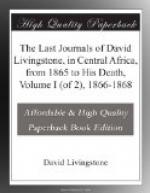FOOTNOTES:
[9] Further on we found it called Nkonya.
[10] It will be remembered that this German traveller was murdered near Lake Nyassa. The native chiefs denounced his assassins, and sent them to Zanzibar, where they were executed.—ED.
[11] Further westward amongst the Manganja or Nyassa people the Waiyan tribe is called “Ajawa,” and we find Livingstone always speaking of them as Ajawas in his previous explorations on the River Rovuma. (See ’The Zambesi and its Tributaries.’)—ED.
CHAPTER III.
Horrors of the slave-trader’s track. System of cultivation. Pottery. Special exorcising. Death of the last mule. Rescue of Chirikaloma’s wife. Brutalities of the slave-drivers. Mtarika’s. Desperate march to Mtaka’s. Meets Arab caravans. Dismay of slavers. Dismissal of sepoys. Mataka. The Waiyan metropolis. Great hospitality and good feeling. Mataka restores stolen cattle. Life with the chief. Beauty of country and healthiness of climate. The Waiyan people and their peculiarities. Regrets at the abandonment of Bishop Mackenzie’s plans.
19th June, 1866.—We passed a woman tied by the neck to a tree and dead, the people of the country explained that she had been unable to keep up with the other slaves in a gang, and her master had determined that she should not become the property of anyone else if she recovered after resting for a time. I may mention here that we saw others tied up in a similar manner, and one lying in the path shot or stabbed[12], for she was in a pool of blood. The explanation we got invariably was that the Arab who owned these victims was enraged at losing his money by the slaves becoming unable to march, and vented his spleen by murdering them; but I have nothing more than common report in support of attributing this enormity to the Arabs.
20th June, 1866.—Having returned to Metaba, we were told by Kinazombe, the chief, that no one had grain to sell but himself. He had plenty of powder and common cloth from the Arabs, and our only chance with him was parting with our finer cloths and other things that took his fancy. He magnified the scarcity in front in order to induce us to buy all we could from him, but he gave me an ample meal of porridge and guinea-fowl before starting.
21st June, 1866.—We had difficulties about carriers, but on reaching an island in the Rovuma, called Chimiki, we found the people were Makoa and more civil and willing to work than the Waiyau: we sent men back to bring up the havildar to a very civil headman called Chirikaloma.
22nd June, 1866.—A poor little boy with prolapsus ani was carried yesterday by his mother many a weary mile, lying over her right shoulder—the only position he could find ease in,—an infant at the breast occupied the left arm, and on her head were carried two baskets. The mother’s love was seen in binding up the part when we halted, whilst the coarseness of low civilization was evinced in the laugh with which some black brutes looked at the sufferer.




